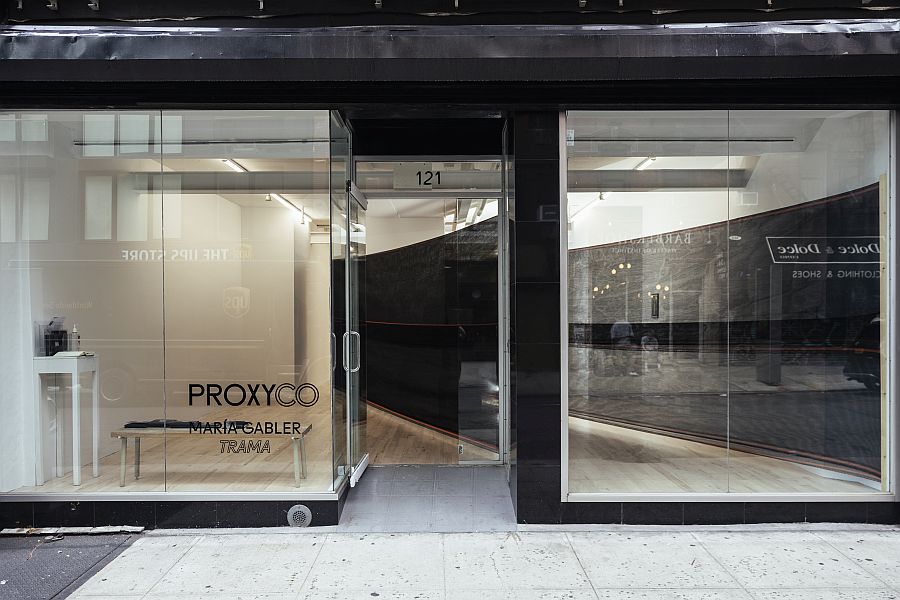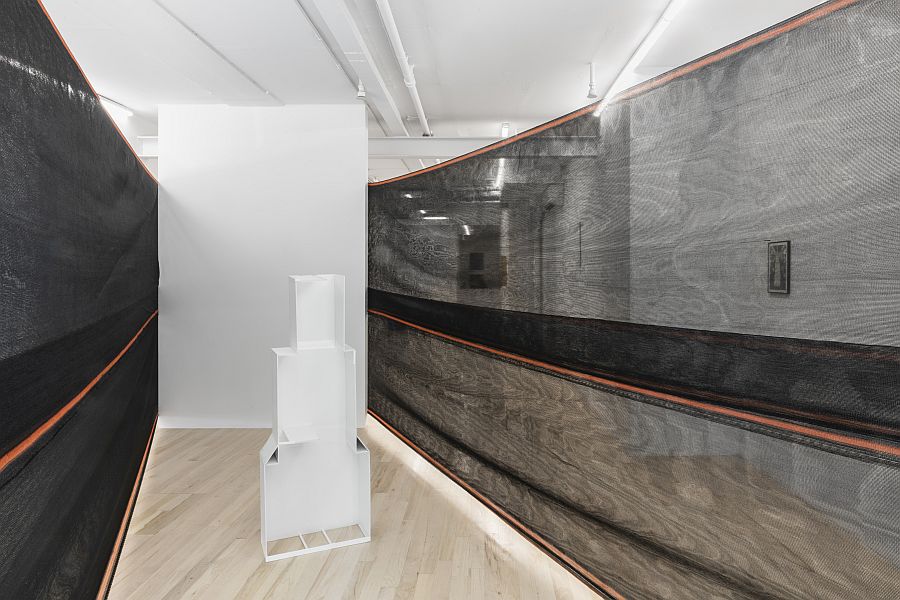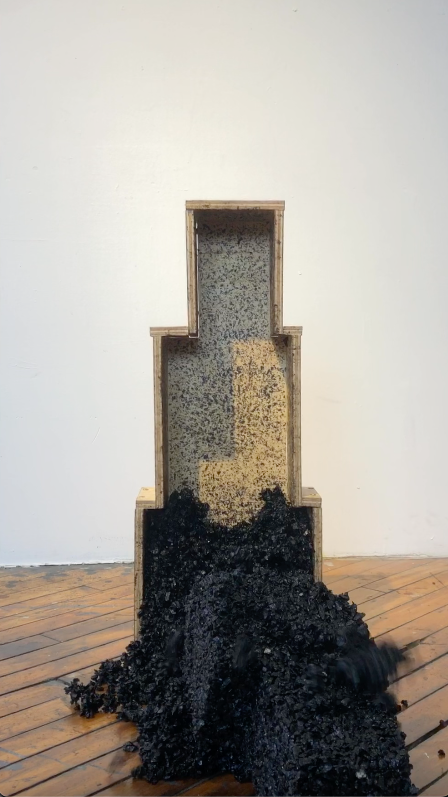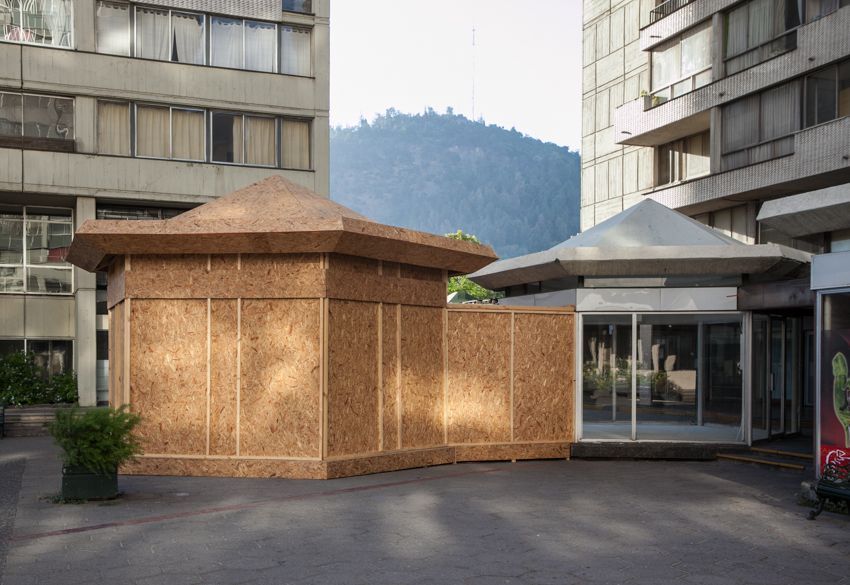
POST-TRAUMA
After getting in María Gabler’s solo exhibition, Trama, at Proxyco Gallery, seeing a video, a piece of plywood and a plywood crate, I rushed into the much more content filled last space, only to find that it was “employee only.” That was it? I wondered.

Then I wandered back, to the entrance, and found out a new story: the “entrance space” I rushed through was a major intervention of the exhibition.
This speaks much to the theme of the exhibition. Using everyday objects on the streets of New York—the mesh to enclose a construction site, the asphalt that lays the roads, the plywood that goes way back in María’s oeuvre that serves as formwork for the concrete forest—that are ghost materials which significantly create our environment, María is bringing them to the forefront of our awareness.
The “original” entrance space is actually double bayed compared to what I first perceived. It is recreated by installing a black mesh envelope that starts from the middle mullion between the two bay-ed storefront windows and the entrance doorway, enclosing a short wall-slab on the side of the entrance, and circle back to the other side of the window, which is also the edge of the space. The result is a new entrance space that I experienced, with a black meshed “wall” and a white plastered wall leading to a small entrance gap that one needs to turn sideways in order to squish through, that I rushed in unnoticed, in order to get into the “exhibition space” that I found all the “art objects.”

Paying attention to the mesh, I also see through it to find a white object of the same shape with the plywood crate I saw earlier on the wall and in the video—a stacked tower with three rectangles, much reminds one of SANAA’s New Museum nearby—but with its flat back facing towards me, and the opening facing towards the window. I had to come out of the gallery to see the “displayed object” through the storefront window. Then it surprised me, the crate was not a crate with an enclosure and void inside, but a model of the architectural space of the gallery itself, laid vertically. It is the extension of the gallery space, that you have to go outside of which in order to see. Meanwhile, the black mesh created a storefront window that blocked the whole gallery in order to highlight the model that shows it.


The moment I realized it, everything changed, one starts to see other things.
I went back in, picked up an exhibition handout from the other hidden corner of the entrance space, checked out the artwork intros, and found out that there is another work that I have missed, a photograph of the “white tower” on a New York subway. It was only through Maria’s guidance that I found it, in the other “leftover” part of the “original” entrance space on the other side of the mesh enclosure, hidden by the change of width of the rectangular spatial stackings as well as the blockage of the meshed space.

The whole exhibition is about “now you see, now you don’t.” It enables vision to the ghost objects that are so obvious around us.
It is also not just about seeing, but it is about embracing their materiality, even literally.
As mentioned, in order to pass through the gap that leads to the next space, one turns sideways. Because the “permanent” wall is parallel to the line of the direction of movement, in comparison to the corner of the “temporary” meshed enclosure, one automatically turns towards the latter, embracing the material so common to the city, used as “ephemeral” structures that veils the “monumental” tower to be erected on the other side. It finally became the protagonist to be engaged with, even if that happens in the second time of passing: in case you missed it, like I did, for some temporary curatorial gesture that set up the exhibition’s scenography before entering the “official” gallery. The event is achieved in an intentional spatial and directional arrangement different from the passing with a choice by Marina Abramovic and Ulay’s Imponderabilia (1977).


Same experience happens with the materiality of the asphalt and plywood. In the video, one sees the asphalt, filled in the “formwork” of the plywood, slowly falling out and down, into a pile on the floor. This leads to the plywood formwork eventually being displayed as an “object of art,” a “tower,” in the gallery, with traces of the asphalt that once inhabited it. The movement was so slow and subtle, that one doubts whether the screen is displaying a photograph or a video. Similarly, because of the shoot’s frontal angle, there was no depth of the asphalt: it was a black image until it starts to fall. Such instability or undecidability between two-dimension and three-dimension was a recurring theme in María’s works, from the dark interior becoming a black wall in Mirador (2015) to the garden exterior becoming a lighted illustration in La Ventana (2022). But in this case, the slow speed of the video also more closely reveals the asphalt’s materiality, its stickiness, that enables the falling in such a specific way.






As if this was not enough, the small piece of even more asphalt-traced plywood diagonally across from the crate, and the only “art object” inhabiting the middle volume of the stacked gallery space, is a mysterious existence. It is actually the “auxiliary tool” used to put the asphalt into the crate, while embraces equal visibility and status of its objecthood with the video of the content falling out of the “formwork,” as well as the “formwork” becoming a “monument tower.” As for the other “monument tower,” the white one that is excluded as well as highlighted by the mesh, it is a lent “auxiliary” model from the gallery to the artist at the very beginning of this exhibition’s incubation.

It first achieved such tower-hood accidentally in the subway of New York due to the cramped space, as revealed by the hidden photograph—a gesture that dis-credit the auxiliarity, the monumentality, the artist’s individuality, as well as the gallery’s integrity: the model does not depict the gallery in its entirety despite of the represented enclosed walls, the initial targeted space that I rushed to was not included. It was the “employee only” hidden space for the administration of the gallery as well as the art market ecology behind its public artistic presentations, where I happily found the hidden refreshment once I courage up to break the boundary.

I asked María why the exhibition was called Trauma, unexplained anywhere despite the word’s eye-catching dramatic promise. She said that it is actually the Spanish term “Trama”, meaning material thread or plotline. Maybe the actual Trauma is not seeing the Trama, to learn to unsee the programed lens (such as the predominant English language connotation, or the established gestalt that leads to autocomplete), and to materially develop a line that access other places.
*Editor’s Note: The confusion stems from the fact that when read by an English speaker, the word “Trama” has a sound similar to that of “Trauma” (tɹɑ-mə), since the “u” is not vocalized.
This exhibition by the winner of the 2021 CCU Art Scholarship at Proxyco Gallery (New York) is the result of four months of research that the artist carried out during her residency at the International Studio & Curatorial Program in NY.
También te puede interesar
ENTIDADES VIVIENTES EN COLECCIONES ENCICLOPÉDICAS. OBRAS RECIENTES DE GALA PORRAS-KIM
Dos exposiciones presentan su obra más reciente: "Precipitación para un paisaje árido", en Amant, Nueva York, con obras basadas en referencias arqueológicas; y "Out of an instance of expiration comes a perennial showing", en...
CONVOCATORIA: ENCUENTRO FRAGUA III (VALDIVIA, CHILE)
Con un total de 14 cupos disponibles, el programa invita a personas mayores de 18 años, de nacionalidad chilena o extranjera, residentes o no en el país, a postularse para participar en esta experiencia...
Public Interventions:phantom Railings
Phantom Railings es la primera instalación de Public Interventions, colectivo creado por la chilena residente en Londres Catalina Pollak. Forma parte del Centre for Creative Collaboration de la Universidad de Londres y tiene como…



